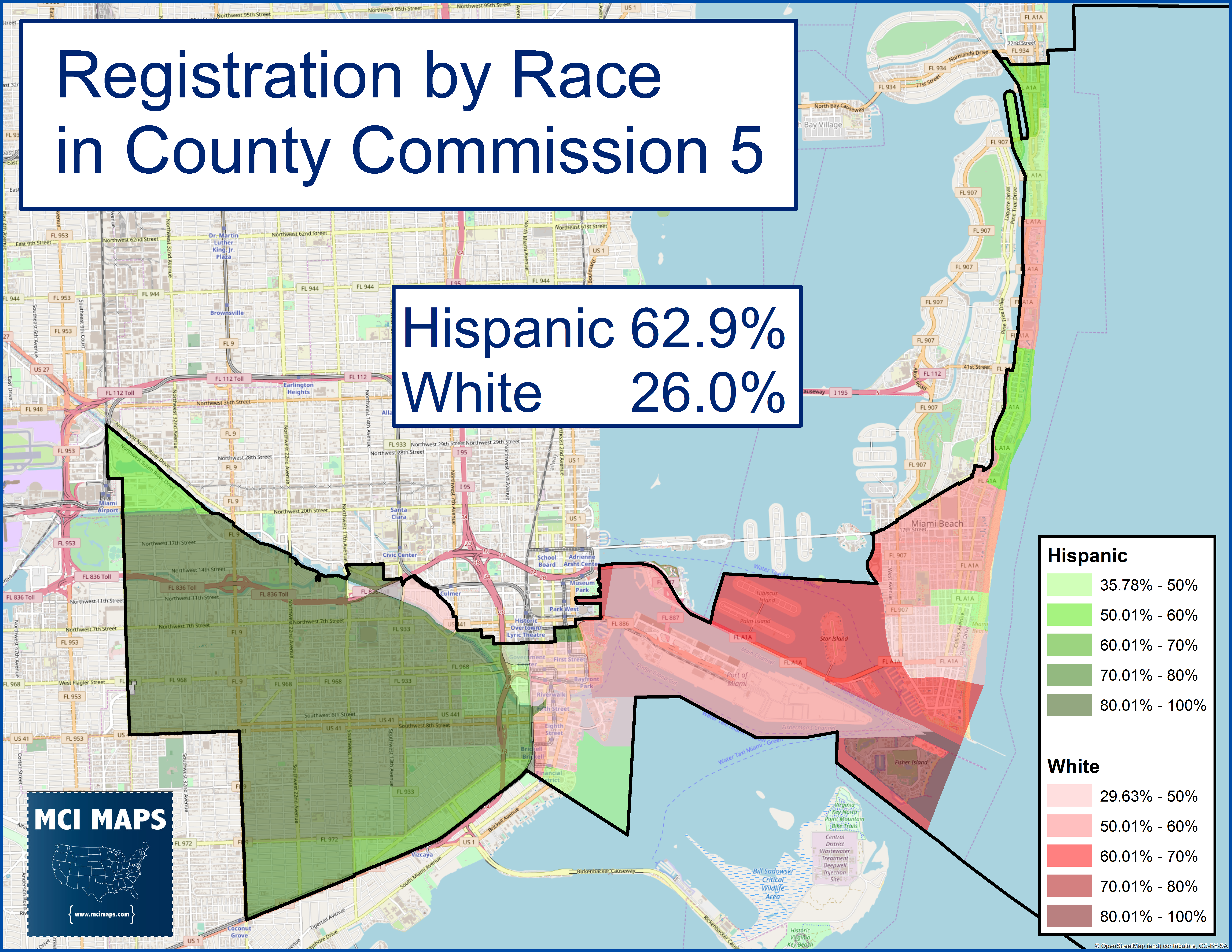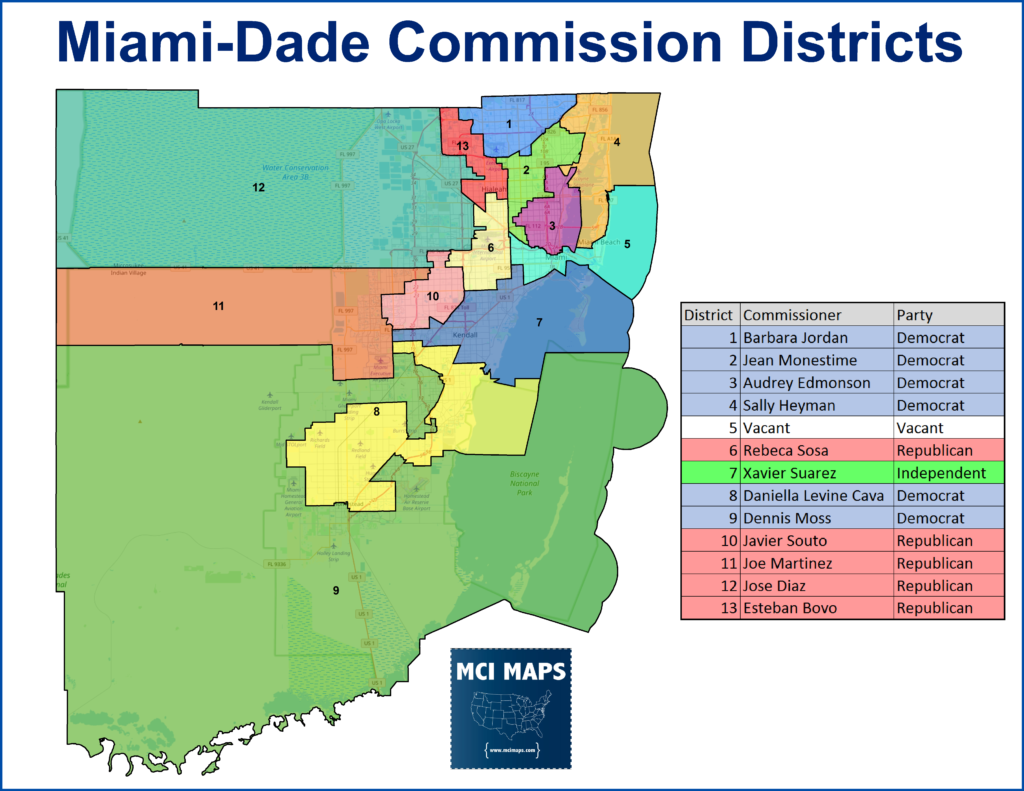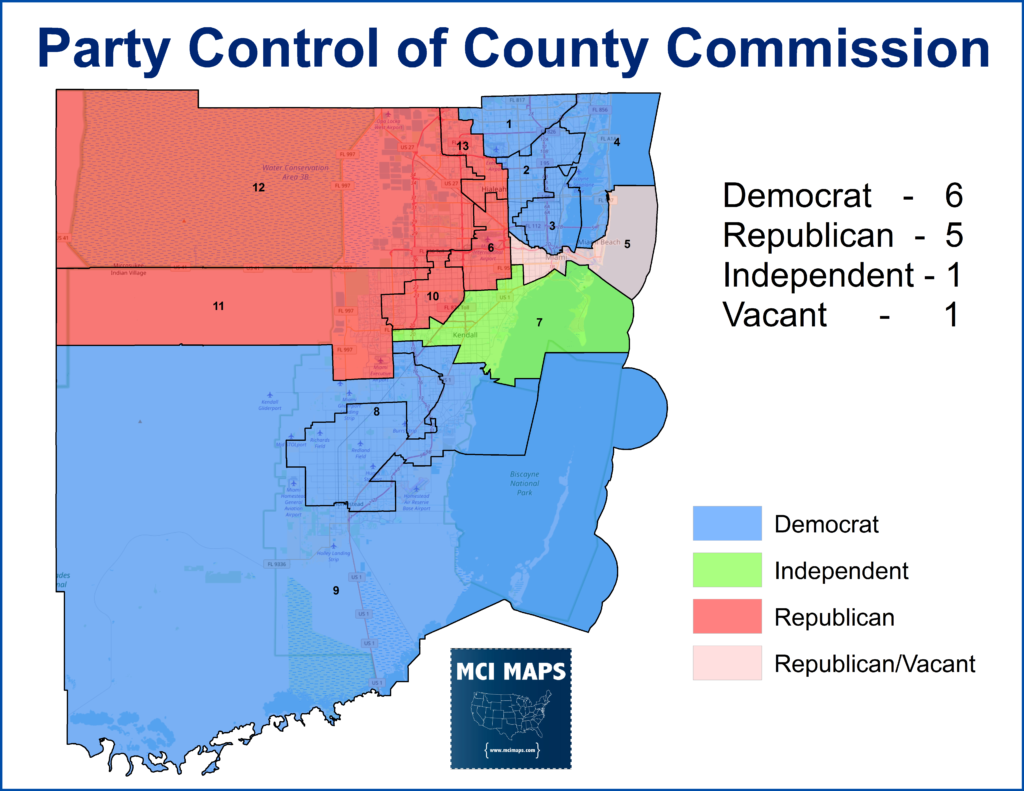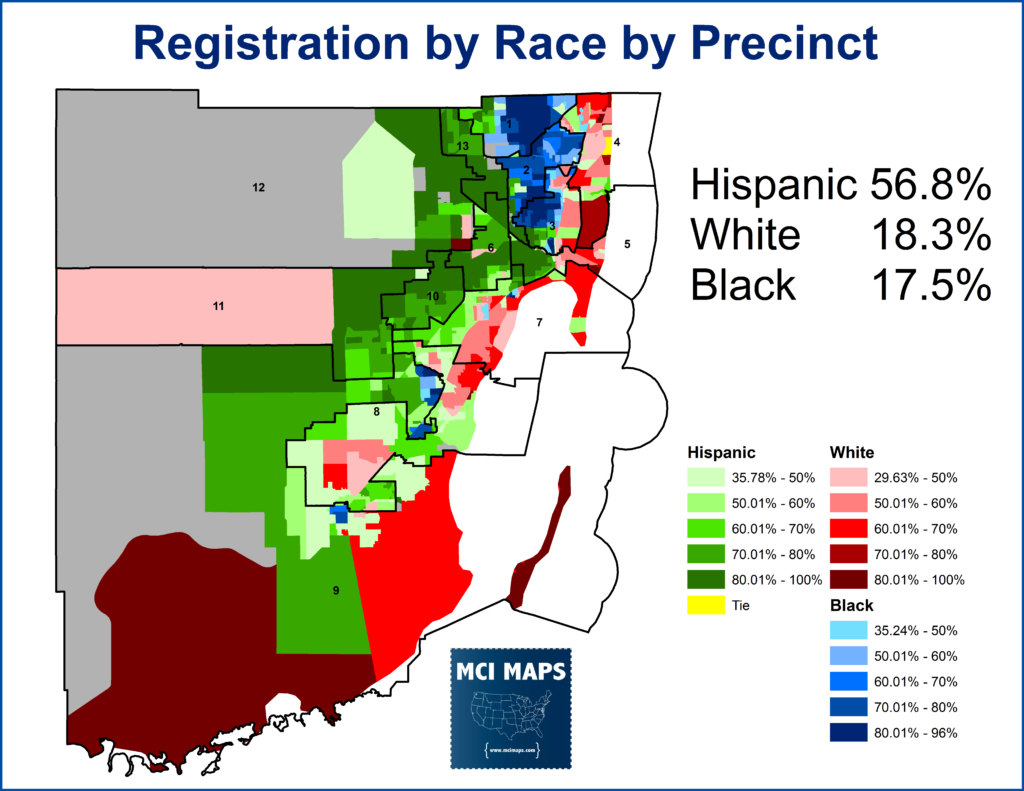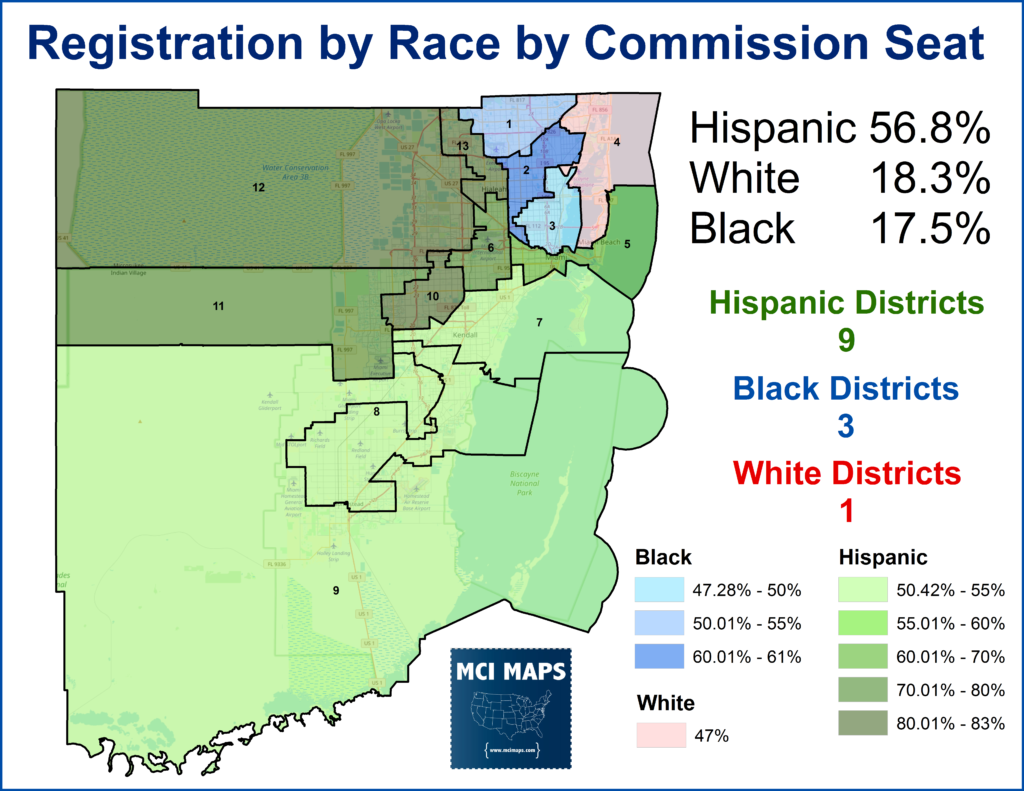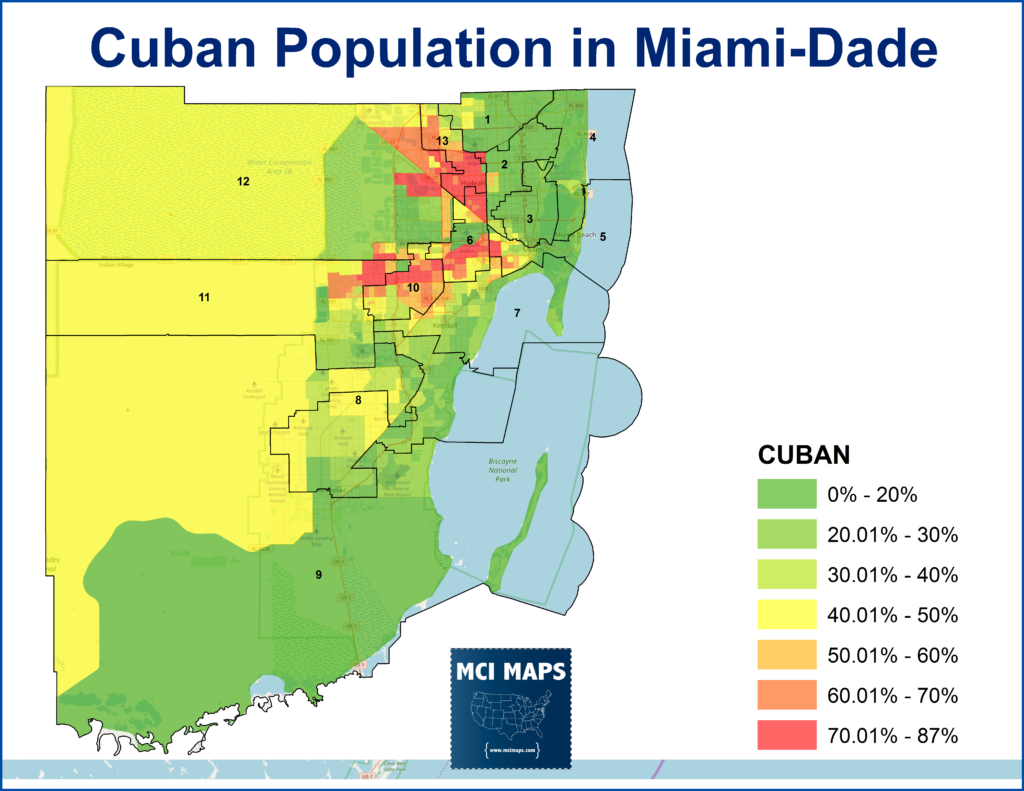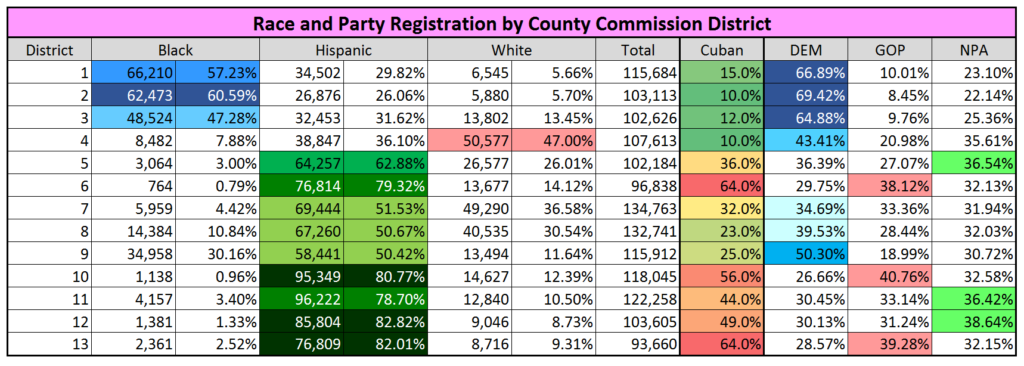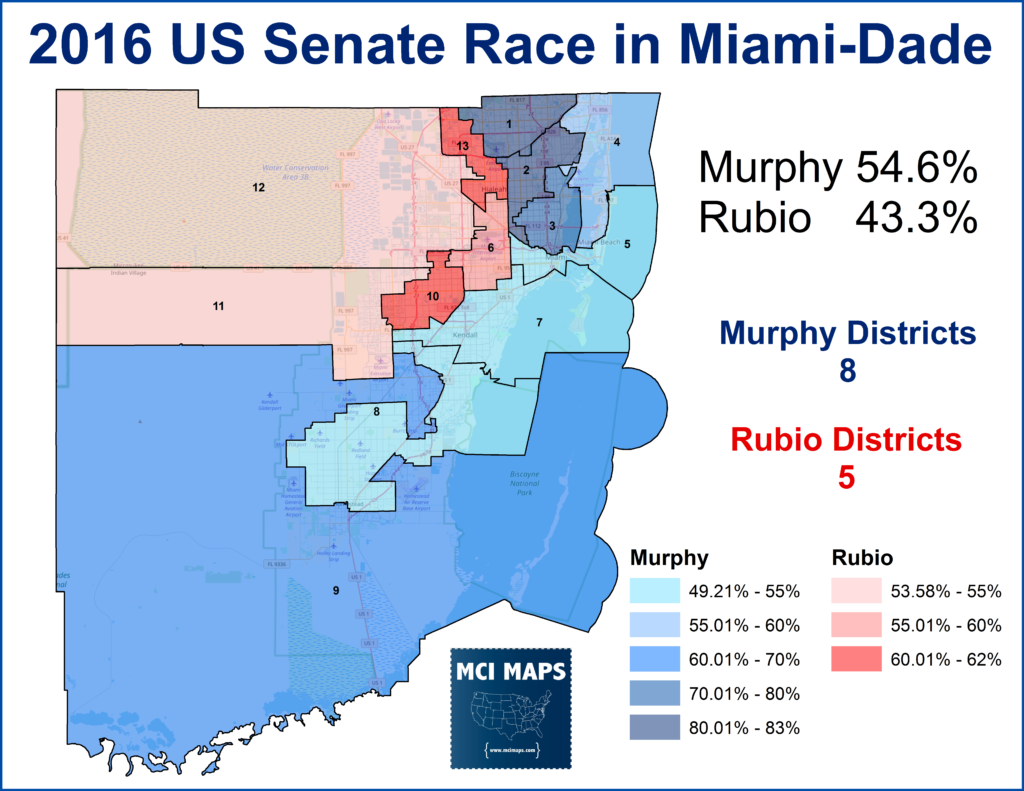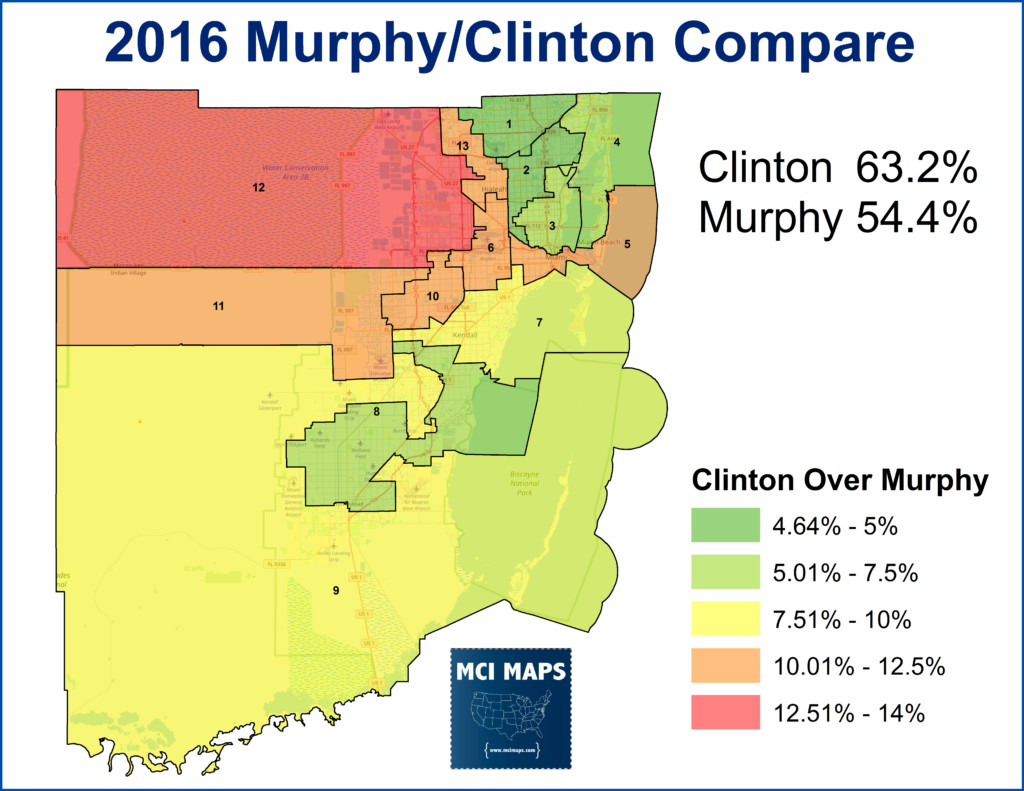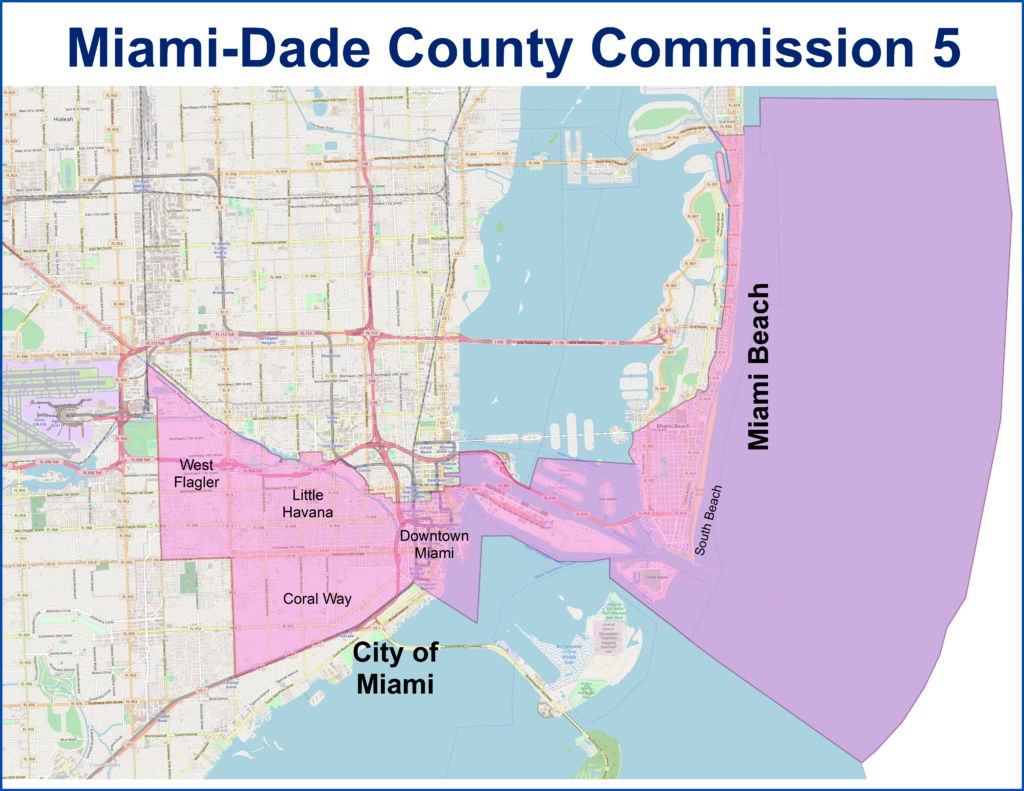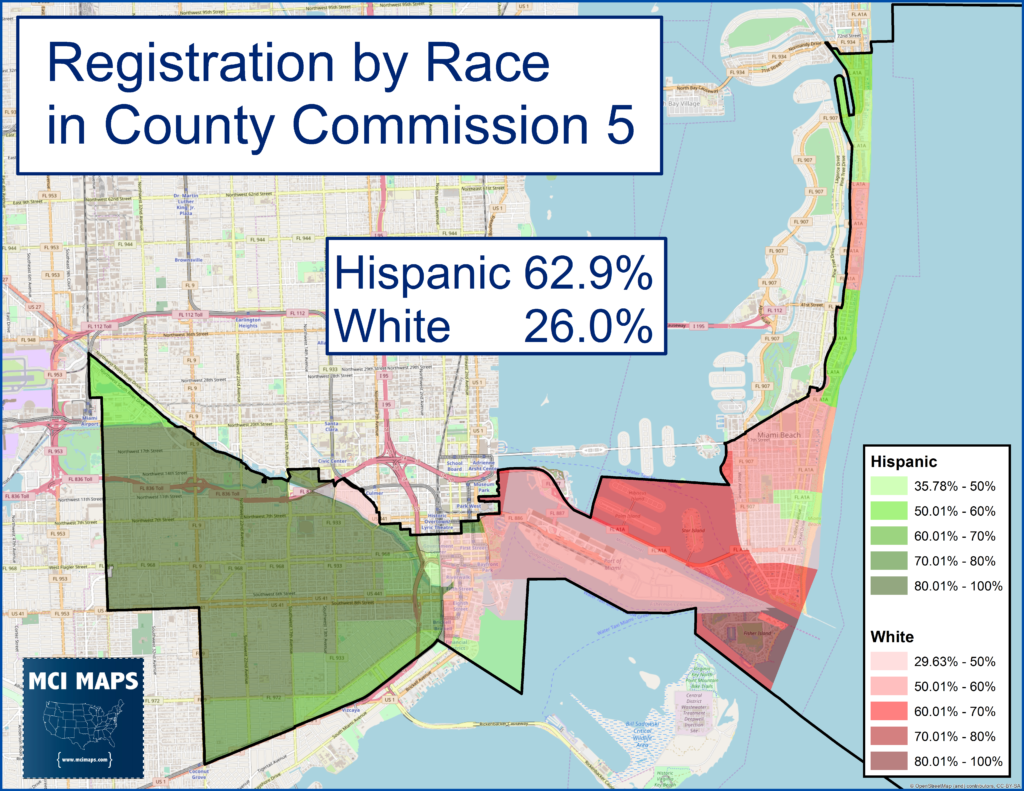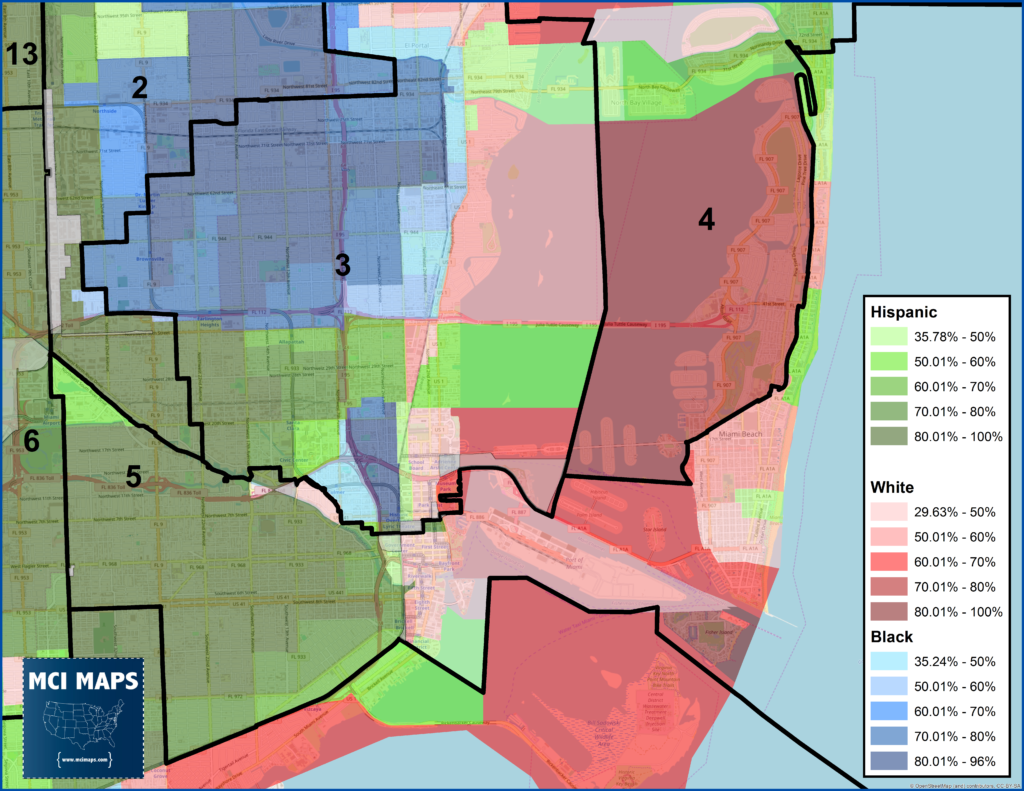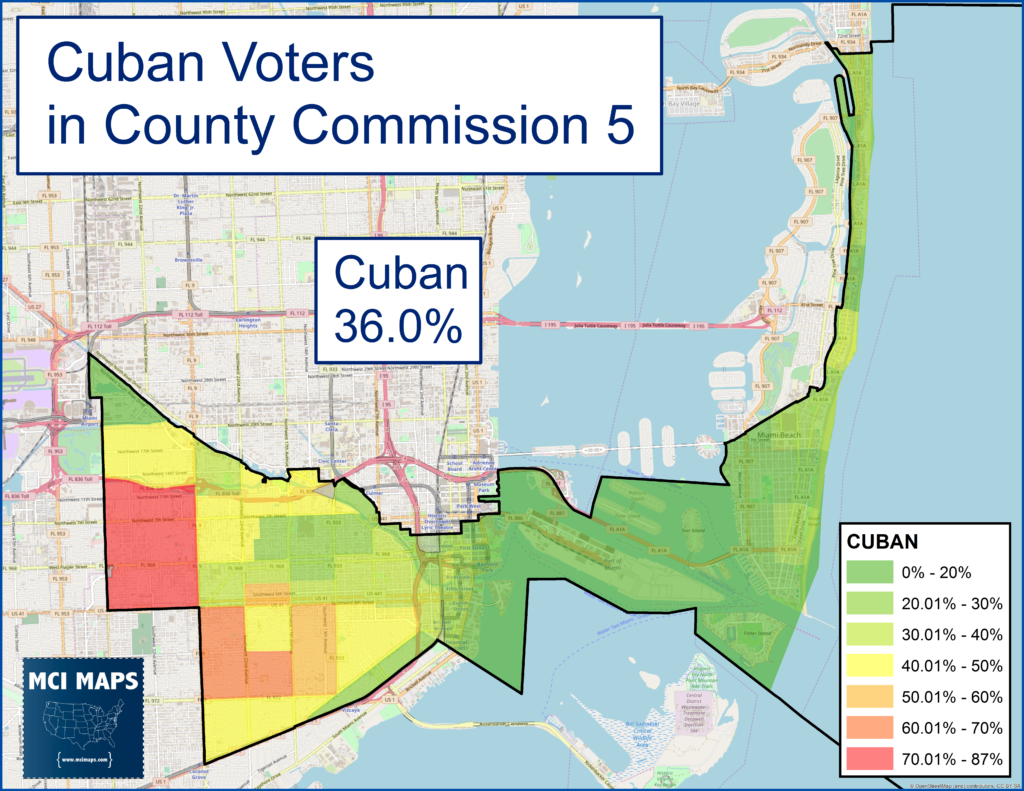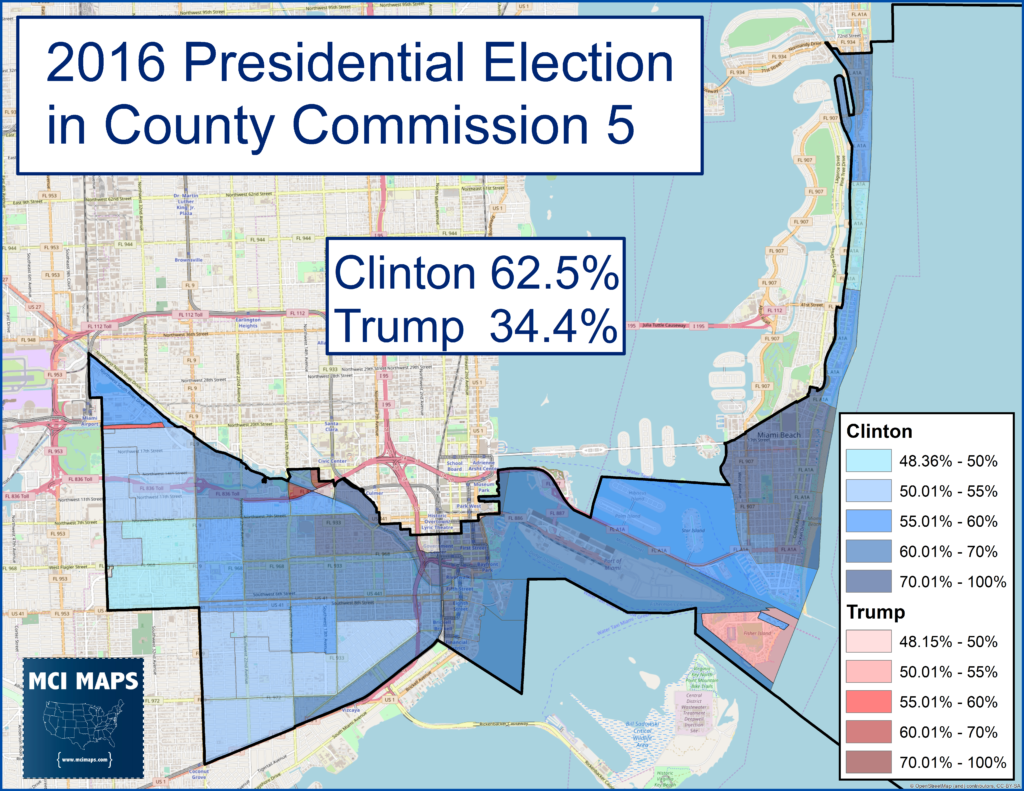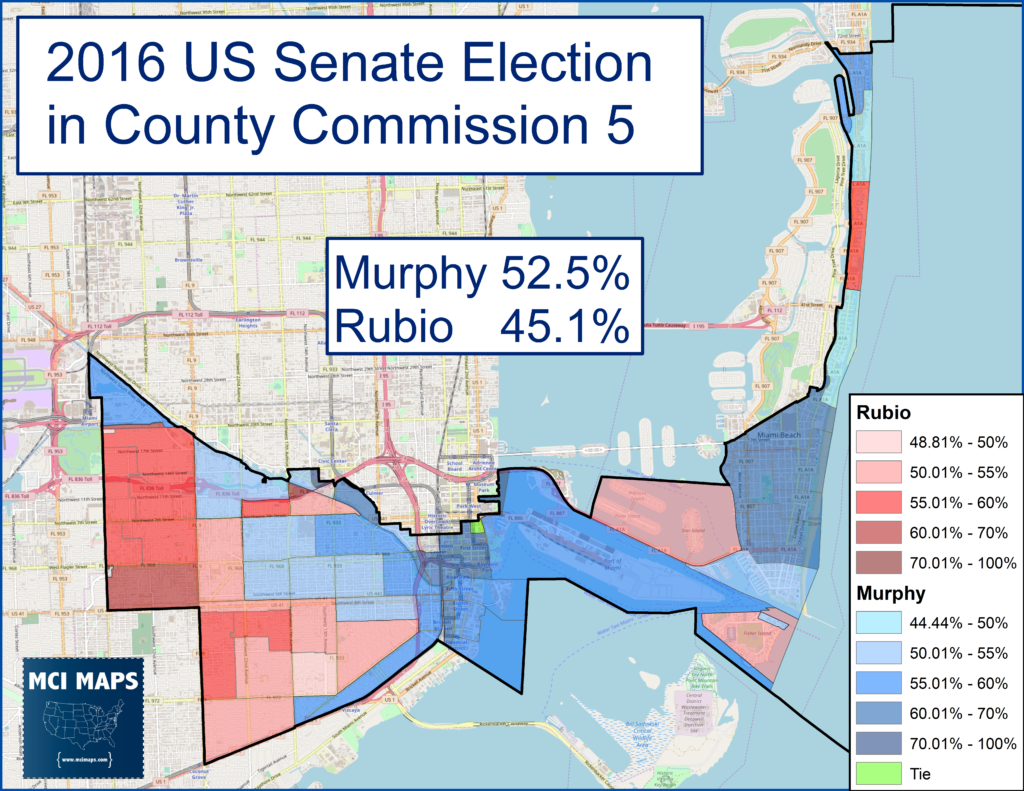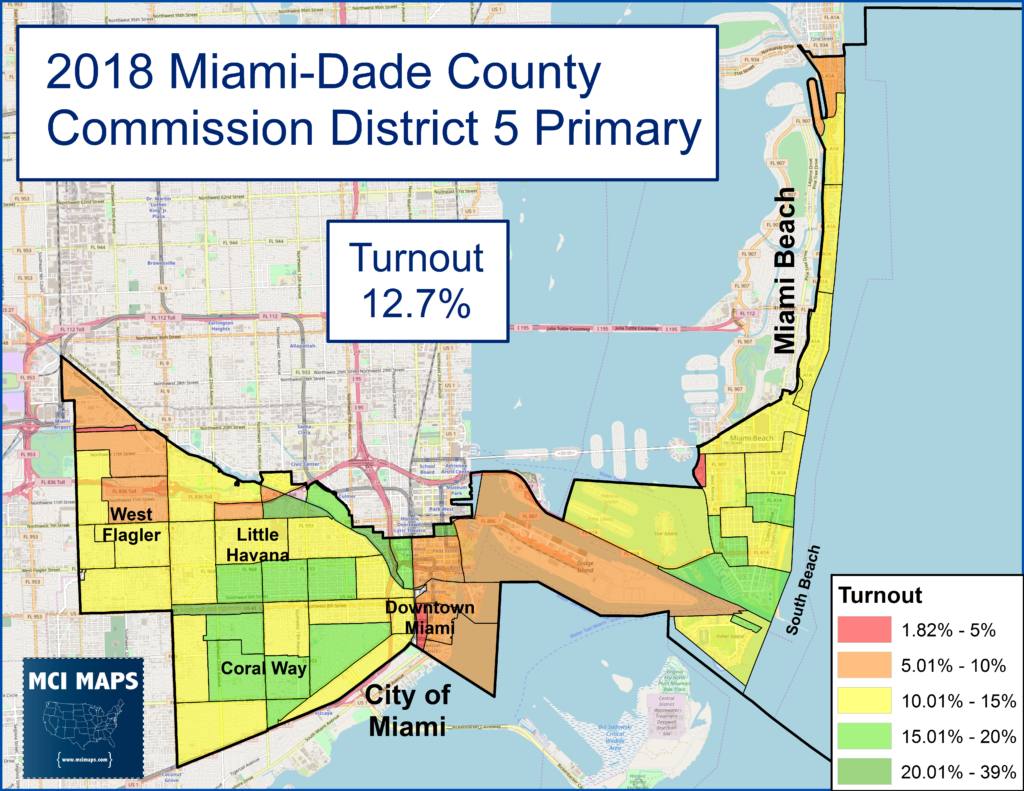At the end of March, longtime County Commissioner Bruno Barreiro announced he was resigning from the Miami-Dade commission to run for the Florida 27th district in the GOP primary. The resignation has resulted in a special election for his seat, the 5th district. The race has been largely characterized as a clash of prominent GOP families, but I believe there is an opportunity for Democrats to make it out of the first round of voting and advance to the runoff. First, lets take a look at the current politics of the Miami-Dade commission as well as the breakdown of the 5th district.
Miami-Dade County Commission
Miami-Dade, home to 1.4 million registered voters, splits its county government into 13 single-member districts. All commissioners serve four year terms and are elected on a non-partisan ballot. Despite the non-partisan elections, the party allegiance of commissioners are well known in political circles.
Before the vacancy in district 5, the commission was tied at 6 Democrats, 6 Republicans, and 1 true Independent. The vacancy in a GOP-held seat left Democrats with a narrow advantage on the board. Republican seats are concentrated in the heavily Hispanic/Cuban communities. Democrats, meanwhile, are strong in the African-American districts; as well as the Hispanic, but less Cuban, districts of South Dade.
Party affiliation of these officials can be important but there are many instances were party lines blur. Depending on the issues, democrats or republicans may split over an issue. After 2014, when Democrats netted a pickup in County 8, creating the tie, the race for county Chair was fought between two democrats. While there are tensions at times, there is also a good deal of respect among commissioners and far less political division that you see in the state legislature. The 2014 race for County 8 took on strong partisan ties as Republicans worked to defend their incumbent while Democrats aimed to take the seat. Now, in this special, all Democrats on the commission, as well as Independent Suarez, have backed the Democrat running.
The Miami-Dade commission lines are heavily influenced by race. I could go into far more detail on where the lines are good or need improvement. However, in general, these lines work to reflect the demographic reality of the county. Lines aim not just to group like-minded races, but also communities of similar national origin.
The result of these lines are 9 Hispanic districts, though the 7/8/9 are more modestly Hispanic, 3 African-American districts, and 1 white district.
The 9th district is actually represented by an African-American. Dennis Moss, with the district being made up of 30% African-American voters. The southern Dade seats are more diverse with Hispanic advantages.
Cuban voters, a major voting block in Dade, are strongest in the 13th, 10th, 11th, 6th, and 12th districts.
All major demographics are listed below.
Overall it would be hard to argue the district aims to be a political gerrymander. Major issues are clear preferences by commissioners to have certain communities in their seats.
Miami-Dade Commission Political Leanings
When Hillary Clinton won Miami-Dade with a record 30 point margin, she wound up winning 11 of the 13 districts. The only seats that remained with Trump were the heavily Cuban 13th and 10th. Both still backed Trump, but with the weakest showings for any GOP Presidential candidate in modern history.
Of course, Trump’s record poor performance with Hispanics is the high-water mark for Democrats. A more neutral race was the US Senate fight, featuring home-town politician Marco Rubio. Democrat Patrick Murphy won Dade by 11 point and carried 8/13 districts. The Heavily Hispanic/Cuban districts of the west stuck more with the GOP, but Democrats took African-American, white, and non-Cuban Hispanic seats.
Note than in both cases the 5th district, our special election, went for the Democrats.
In some districts, the difference between Clinton and Murphy were minimal; while in the more Cuban-centered seats, the gap was much larger.
As the special elections for SD40 and HD114 have shown, top-of-the-ticket margins can only give so much insight into the political leanings of Miami-Dade districts. Cuban Americans are growing more Democratic for the top of the ticket; but the story is different when Cuban Republicans appear on the ballot. As I discussed on the Washington Post (shameless plug), Miami-Dade has a down-ballot ticket-splitting that is similar to the old American South. Voters are prepared to split tickets, especially when the Republican running is someone they know. This is how local Democrats survived so long in the South even though the GOP was taking the electoral votes every time.
The Fifth District
The special election On May 22 will be in the 5th district, located in the cities of Miami and Miami Beach. Both cities are split by the district. Miami Beach sees its Southern neighborhoods and coastal/condo communities separated from western communities of the city. The lines split Maimi-Beach between its more condo-heavy communities and its western communities, which are more dominated by traditional single-family homes. Meanwhile, the heavily Hispanic Miami neighborhoods of West Flagler, Little Havana and Coral Way are added into the district.
The district is 63% Hispanic. white condo communities in Miami Beach are paired with more mixed coastal communities and the heavily Hispanic West Miami block.
The Miami-Beach split is even clearer when looking at the racial makeup of the surrounding precincts. The heavily white singe-family home neighborhoods are added to the 4th, which is the county’s lone white-plurality district.
The district isn’t as Cuban as some of the other Hispanic districts, but it still hovers around a third. The Cuban community is concentrated in the West Miami ends of the district.
Donald Trump’s well-documented trouble with Hispanic voters resulted in him getting crushed in the 5th district. He lost the district by nearly the same margin he lost Dade County as a whole. His only notable win was in Fisher Island, one of the wealthiest communities in America. Trump did not even take the Cuban communities in this portion of the county.
The US Senate race, held that same day, shows GOP strength in the traditionally Cuban areas as well as in high-end condos of Miami Beach. However, Murphy still secured a respectable 7% win.
At this point the district is becoming much more Democratic down-ballot. Democrats populated the state house and state senate districts that overlap with this area.
The Primary
Despite the Democratic lean of the district, there is still a real chance two Republicans advance in the first round. As the Miami Herald said, the race is featuring a clash of two political dynasties.
- Alex Diaz de la Portilla – Former State Senate Majority Leader. Prominent political family, with many members holding office in Miami-Dade. Raised $90K
- Zoraida Barreiro – Wife of resigned commissioner, had run for Miami City Council in 2017. Establishment favorite. Raised $140K
Note these fundraising numbers are hard money only. There are political committees involved as well.
There is no love-loss between these two camps. Portilla consulted for the man who ultimately beat Barreiro in her city commission run just last year. Both campaigns have gone negative on each-other, with Portilla really playing to older Cuban exiles by claiming Barrerio has been weak on Cuba. Barreiro has more money and lots of strong institutional backers, many who have grown tired of Portilla’s antics, and its widely believed that deciding to spend $1 million on a special election, rather than hold off till the August primaries, was designed to aid Barreiro with a short campaign.
As these two heavyweight Republicans clash, Democratic activist Eileen Higgins stepped up to give Democrats someone in the race. While focus has been on Portilla vs Barreiro, Higgins has launched an aggressive campaign. She raised $50,000 has appears to have a strong volunteer base working the district to secure a runoff spot. She has received union backing and the support of all Democratic commissioners, as well as the lone independent.
The goal for Higgins is no doubt to make a runoff. Many still expect a Portilla/Barrerio runoff but I believe that is premature. The non-partisan ballot no doubt helps the Republicans, but as they fight and clash with each-other, it could open the door for Higgins. If this was a partisan ballot, Higgins making the runoff wouldn’t even be in question.
Turnout will be critical, and likely helps the GOP. Absentees will be the largest vote source and that is dominated by older voters. Older Cubans are more likely to stick between Portilla and Barreiro, while Miami-Beach retirees may be more fertile for Higgins. Election Day turnout, made up of younger, less Cuban voters are also likely critical for Higgins.
Don’t expect anyone to win outright on Tuesday. If Higgins makes the runoff should could see a big jump in fundraising and momentum, as it will be viewed as an upset. I’d say Barrerio is favored to make the runoff, with Portilla and Higgin being the two fighting for the other slot. Polls close at 7pm.
Primary Results
The primary results are in, and Higgins not only secured a runoff spot, she came in first. Barreiro was close behind, while Alex de la Portilla finished in 3rd; making the latest political defeat for the Portilla family. Higgins was especially strong in most of Miami-Beach and won pluralities in Coral Way. Meanwhile, the Cuban/Hispanic community split between Portilla and Barreiro, with Portilla taking the more-Cuban West Flagler and Barreiro strongest in Little Havana.
Absentees were over 60% of the vote cast. Higgens actually did fairly well with absentees considering they leaned more toward older Cuban voters. She dominated election day, which propelled her to first place.
Turnout was low, as to be expected with Dade special. It is notable that turnout was similar in parts of Miami-Beach compared to the Cuban communities. Cuban absentee return rate strength appears to have been equalized by stronger election day turnout among other voting groups.
We now go into a runoff in June. Right now the GOP has the advantage in that the GOP candidate share of the vote was over 60%. Democrats, however, now have momentum, which will hopefully lead to a fundraising boost. The big question for the runoff will be how many Portilla voters stay home (most would likely go to Barreiro otherwise) and how many new voters show up. Both parties will likely aim to increase turnout, so don’t be shocked if the runoff seeing a turnout uptick. The makeup of the runoff, whether due to new voters or May voters staying home, will likely decide the race.

